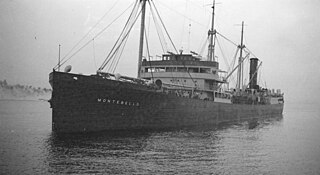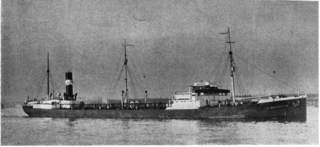
Hammac was a steam tank ship built in 1920–1921 by Bethlehem Shipbuilding Corporation of Alameda for the United States Shipping Board as part of the wartime shipbuilding program of the Emergency Fleet Corporation (EFC) to restore the nation's Merchant Marine. Early in 1923 the vessel together with two other tankers was sold to General Petroleum Corporation and renamed Emidio. The tanker spent the vast majority of her career carrying oil along the West Coast of the United States as well as between West and East coast. In December 1941 she was shelled and damaged by the Japanese submarine I-17 and eventually wrecked with a loss of five crew.

W. L. Steed was a steam tanker built in 1917–1918 by Bethlehem Shipbuilding Corporation of Quincy for Pan American Petroleum and Transport Company, with intention of transporting oil and petroleum products between Mexican and Gulf ports and the Northeast of the United States. The ship was briefly requisitioned by the US Government during World War I but returned to commercial service in early 1919. The ship was named after William L. Steed, superintendent of the Mexican Petroleum Company of California.
Cotati was a steam cargo ship built in 1918–1919 by Moore Shipbuilding and Drydock Company of Oakland for the United States Shipping Board (USSB) as part of the wartime shipbuilding program of the Emergency Fleet Corporation (EFC) to restore the nation's Merchant Marine. The vessel was briefly used for the first two years of her career to transport frozen meat between North and South America and Europe. The ship was subsequently laid up at the end of 1921 and remained part of the Reserve Fleet through the end of 1940. In January 1941 she was sold together with two other vessels to the New Zealand Shipping Co. and subsequently in 1942 was transferred to the Ministry of War Transport (MoWT) and renamed Empire Avocet. The ship was torpedoed and sunk by German submarine U-125 on 30 September 1942 on one of her regular wartime trips.

Montebello was a steam oil tanker built in 1920–1921 by the Southwestern Shipbuilding Co. of San Pedro for Union Oil Company with the intention of carrying oil and petroleum products along the West Coast of the United States and Canada as well as between the United States and Chile. In December 1941 the tanker was sunk on one of her regular trips by the Japanese submarine I-21.
Sylvan Arrow was a steam tanker built in 1917–1918 by New York Shipbuilding Co. of Camden for Standard Oil Company, with intention of transporting oil and petroleum products between United States and ports in the Far East. The ship was briefly requisitioned by the US Government during World War I but returned to commercial service in early 1919.
Ozette was a steam cargo ship built in 1918–1919 by Seattle North Pacific Shipbuilding Company of Seattle for the United States Shipping Board as part of the wartime shipbuilding program of the Emergency Fleet Corporation (EFC) to restore the nation's Merchant Marine. The vessel was largely employed on the East Coast to Europe routes during her career before she was laid up in and eventually broken up for scrap in 1936.

Corvus was a steam cargo ship built in 1919 by Columbia River Shipbuilding Company of Portland for the United States Shipping Board as part of the wartime shipbuilding program of the Emergency Fleet Corporation (EFC) to restore the nation's Merchant Marine. The freighter was operated on international and domestic routes through 1944. Early in 1945 she was transferred to Soviet Union as part of lend-lease program and renamed Uzbekistan. After several months of operation, the freighter was rammed by another vessel on 31 May 1945 and was beached to avoid sinking. She was subsequently raised and towed to Portland where she was scrapped in 1946.

Wolverine State was a steam passenger-cargo ship built in 1919–1920 by New York Shipbuilding Company of Camden for the United States Shipping Board (USSB) as part of the wartime shipbuilding program of the Emergency Fleet Corporation (EFC) to restore the nation's Merchant Marine. The ship was initially employed on the United States to India route until its cancellation in Spring 1922. After remodeling the vessel was briefly used by the Los Angeles Steamship Company on a run between Los Angeles and Honolulu as an emergency replacement for one of their burned out steamers. In April 1922 the steamer was renamed President Harrison. In 1923 she conducted several trips between California and the east coast of South America, before being sold together with several other ships of her class to the Dollar Steamship Company. The vessel was captured in 1941 by the Japanese after she was deliberately run aground to avoid the capture. After repairs, the ship was renamed Kachidoki Maru (勝鬨丸), put under control of NYK Line and entered the Japan to Taiwan route, but soon after was requisitioned by the Imperial Japanese Army. Under IJA control the ship sailed between Japan, Singapore and the Philippines carrying troops and military supplies. She was torpedoed and sunk on 12 September 1944 on one of her regular trips, while carrying 950 Allied prisoners of war of which 431 were killed.
Byron D. Benson was a steam tanker built in 1920–1921 by Oscar Daniels Shipbuilding Co. of Tampa for Tide Water Oil Co., a subsidiary of Standard Oil, with intention of operating between New York and oil-producing ports of the southern United States and Mexico. The ship was named after Byron D. Benson, founder of Tide Water Pipe Co.

Samuel Q. Brown was a steam tanker built in 1920–1921 by Merchant Shipbuilding Corporation of Chester for Tide Water Oil Co., a subsidiary of Standard Oil, with intention of operating between New York and the oil-producing ports of the southern United States and Mexico.
West Niger was a steam cargo ship built in 1919–1920 by Southwestern Shipbuilding Company of San Pedro for the United States Shipping Board (USSB) as part of the wartime shipbuilding program of the Emergency Fleet Corporation (EFC) to restore the nation's Merchant Marine. The freighter spent her entire career in the Pacific connecting the West Coast of the United States with the Chinese and Japanese ports in the Far East. Early in 1928 the ship together with ten other vessels was sold by the Shipping Board to the States Steamship Co. and subsequently renamed Nevada. In September 1932 the vessel while on her regular trip to Japan ran aground in foggy weather on Amatignak Island and subsequently broke into three parts and sank with the loss of thirty four out of thirty seven men.

China Arrow was a steam tanker built in 1920 by Bethlehem Shipbuilding Corporation of Quincy for Standard Oil Co., with intention of transporting oil and petroleum products between United States and the Far East. During the first part of her career the tanker was used to carry oil and gasoline between United States and Asia, later becoming a coastal tanker serving the East Coast of the United States. The ship was torpedoed and sunk in February 1942 on one of her regular trips by German submarine U-103.
Oklahoma was a steam tanker built in 1907-1908 by New York Shipbuilding Co. of Camden for the J. M. Guffey Petroleum Company, with intention of transporting oil and petroleum products to ports along the East Coast of the United States and Europe. In January 1914 the tanker ran into a gale and broke in two and sank with a loss of twenty six men.
Swiftstar was a steam tanker built in 1920-1921 by Northwest Bridge & Iron Company of Portland for the Swiftsure Oil Transport Co., a subsidiary of the France & Canada Steamship Co., with intention of transporting oil from foreign ports to refineries along the Gulf and East Coasts of the United States. The ship had short but troubled history. In July 1923 after departing Colón the tanker went missing. Large oil slick, burnt remnants and several lifeboats bearing the ships's name were later found indicating the ship exploded. All 32 people on board were presumed lost.
Mielero was a steam tank ship built in 1916–1917 by Fore River Shipbuilding Company of Quincy for the Cuba Distilling Company of New York. The vessel was extensively employed on East Coast to Cuba route during her career and foundered on one of her regular trips in January 1920 with the loss of twenty two men.
Cubadist was a steam tank ship built in 1915–16 by Fore River Shipbuilding Company of Quincy for the Cuba Distilling Company of New York. The vessel was extensively employed on East Coast to Cuba route during her career and disappeared without a trace on one of her regular trips in February 1920.
William O'Brien was a steam cargo ship built in 1914–1915 by New York Shipbuilding Company of Camden for the Carpenter–O'Brien Lumber Company of Delaware. The vessel was extensively employed on East Coast to Europe routes during her career and foundered on one of her regular trips in April 1920.
R. W. Gallagher was a steam turbine-powered tanker built in 1938 by Bethlehem Shipbuilding Corporation of Quincy for Standard Oil Company of New Jersey with intention of operating between the oil-producing ports of the southern United States and Mexico and the Northeast. The tanker spent her entire career in coastwise trade and was torpedoed and sunk on one of regular journeys in July 1942 by German submarine U-67.
Haleakala was a steam cargo ship built in 1919 by Long Beach Shipbuilding Company of Long Beach for the United States Shipping Board (USSB) as part of the wartime shipbuilding program of the Emergency Fleet Corporation (EFC) to restore the nation's Merchant Marine. The vessel was first employed in the Pacific trade before being briefly laid up. She was reactivated in 1922 and entered the South American trade connecting the ports of Argentina and Brazil with a variety of ports in the Northeastern United States. In September 1926 while on one of her regular trips, she disappeared without a trace, possibly foundering in the hurricane with the loss of all hands.

J. A. Moffett Jr. was an oil tanker built in 1920–1921 by the Federal Shipbuilding Company of Kearney for the Standard Oil Company of New Jersey with the purpose of carrying oil and petroleum products. Originally built as a steamship, the vessel had her engines changed in 1927 converting her into a motor vessel. She was torpedoed in 1942, killing the captain, before being abandoned, towed and sold for scrap.







